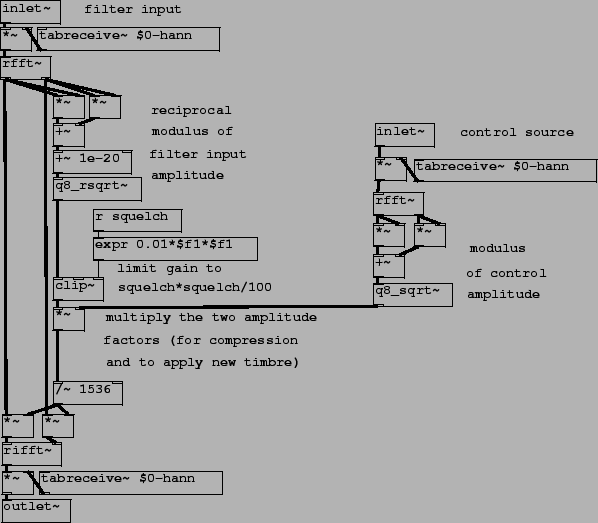 |
Patch I05.compressor.pd is another channel compander which is presented in preparation for patch I06.timbre.stamp.pd, which we will describe next. This is a realization of the timbre stamp of Figure 9.9, slightly modified.
There are two inputs, one at left to be filtered (and whose Fourier transform
is used for resynthesis after modifying the magnitudes), and one at right which
acts as a control source. In the simplest case, if the two magnitudes
are ![]() for the filter input and
for the filter input and ![]() for the control source, we just
``whiten" the filter input, multiplying by
for the control source, we just
``whiten" the filter input, multiplying by ![]() , and then stamp the control
magnitudes onto the result by further multiplying by
, and then stamp the control
magnitudes onto the result by further multiplying by ![]() . In practice, we
must limit the gain to some reasonable maximum value. In this patch this is
cone by limiting the whitening factor
. In practice, we
must limit the gain to some reasonable maximum value. In this patch this is
cone by limiting the whitening factor ![]() to a specified maximum value.
This is done by the clip~ object. The limit is controlled by the
to a specified maximum value.
This is done by the clip~ object. The limit is controlled by the
squelch parameter, which is squared and divided by 100 to make the units
reasonable.
Another possible scheme is to limit the gain after forming the quotient
![]() . The gain limitation may in either case be frequency dependent.
Finally, it is sometimes useful to raise the gain to a power
. The gain limitation may in either case be frequency dependent.
Finally, it is sometimes useful to raise the gain to a power ![]() between 0
and 1; if 1, this is a timbre stamp and if 0, it passes the filter input through
unchanged, and values in between give a smooth interpolation between the two.
between 0
and 1; if 1, this is a timbre stamp and if 0, it passes the filter input through
unchanged, and values in between give a smooth interpolation between the two.